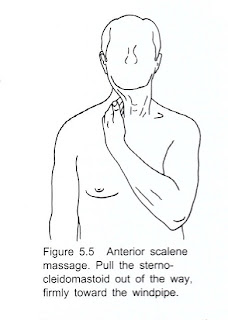 Remember from a previous diagram where the sternocleidomastoidal (SCM) muscle is? Attaches collarbone nobble in the centre, and then right behind the ear. Well, the (front) anterior scalene is right underneath this muscle against the neck vertebrae . To do this, grip the SCM between your fingers and thumb, then let go with your thumb and with your fingers pull the entire SCM toward the windpipe. This allows you to get access to the anterior (front) scalene. Press in hard against the vertebrae and slide - skin and all - approx 1 inch towards the side of the neck. Repeat this movement all the way up the SCM to the ear. You will not experience pain unless you hit a trigger point which can be extremely painful. When finding a trigger point repeat the process on that point up to six times.
Remember from a previous diagram where the sternocleidomastoidal (SCM) muscle is? Attaches collarbone nobble in the centre, and then right behind the ear. Well, the (front) anterior scalene is right underneath this muscle against the neck vertebrae . To do this, grip the SCM between your fingers and thumb, then let go with your thumb and with your fingers pull the entire SCM toward the windpipe. This allows you to get access to the anterior (front) scalene. Press in hard against the vertebrae and slide - skin and all - approx 1 inch towards the side of the neck. Repeat this movement all the way up the SCM to the ear. You will not experience pain unless you hit a trigger point which can be extremely painful. When finding a trigger point repeat the process on that point up to six times.The middle scalenes are located on the side of the neck without being hidden under other muscles. So, without the grabbing part mentioned for the anterior scalenes (ie. just using the slide with fingers) start at the base and move up the neck. You can come back 6 - 8 times during the day and repeat the process. Each time will be easing and retraining these muscles. If you cannot change the cause of the stress to your scalenes (eg. teaching, painting or coughing) then this may need to become a life habit you incorporate into your daily routines.

The (back) posterior scalenes are found not on the neck but, rather on the shoulder. From the front, stick two fingers into the depression where the trapezius muscle attaches to the collarbone. Push down and move towards your throat keeping parallel to the collarbone. Once again the movement is only for approx 1 inch and should move skin and all. The boneiness you feel under your fingers is the top surface of your first rib. The posterior scalene is the primary place for trigger points.
To do this massage successfully your finger nails need to be cut and filed as short as possible, preferably to the quick. These muscles are among some of the most difficult to find and treat, but any massage you give them is highly beneficial. It may be advantageous for you to find a remedial massage therapist who can guide you. Having experienced it once you'll then be able to self-massage more effectively.
Feel free to ask any questions. Or just let me know how this goes for you.
Grateful for the opportunity to share with you.
Diagrams taken from "The Trigger Point Therapy Workbook" by Claire Davies





